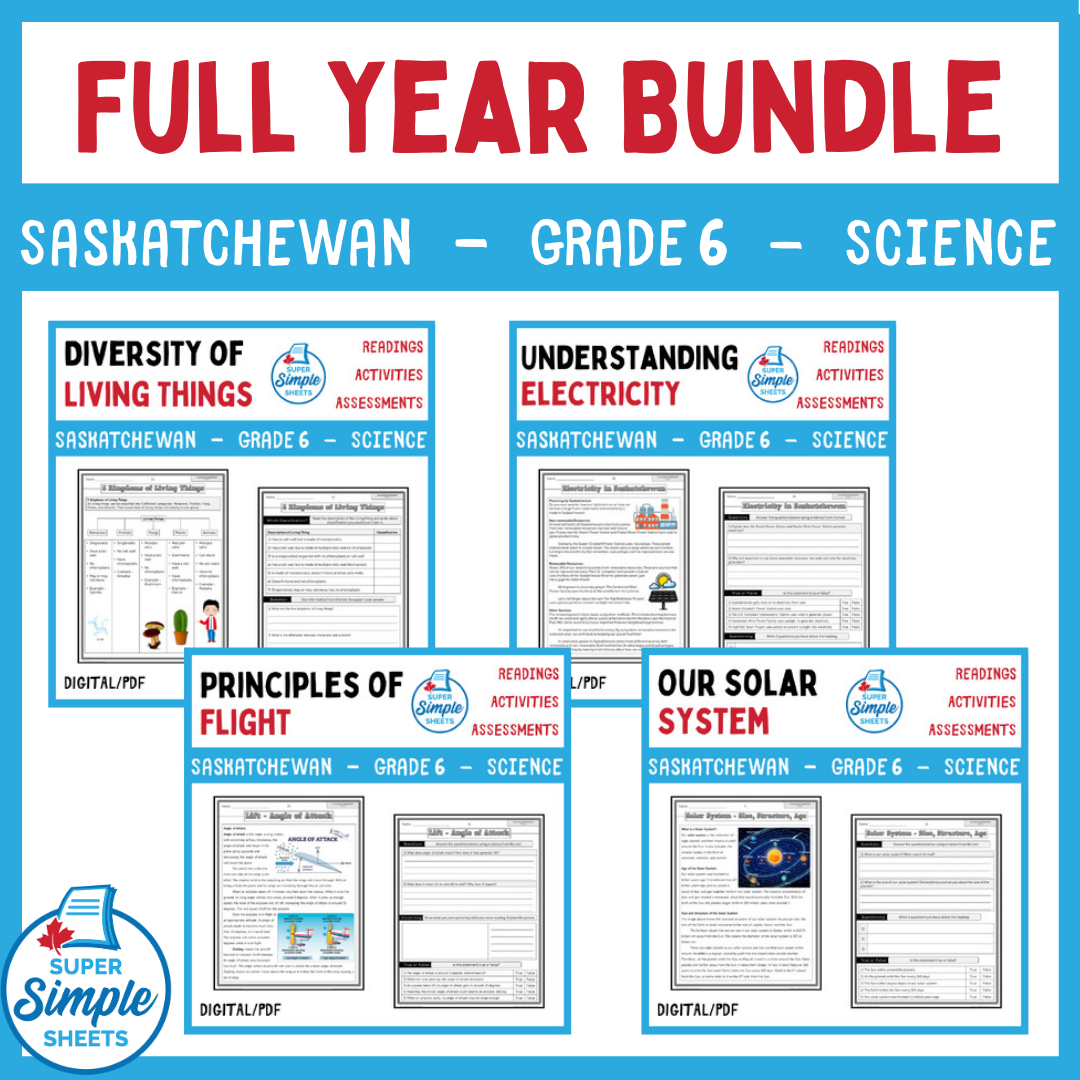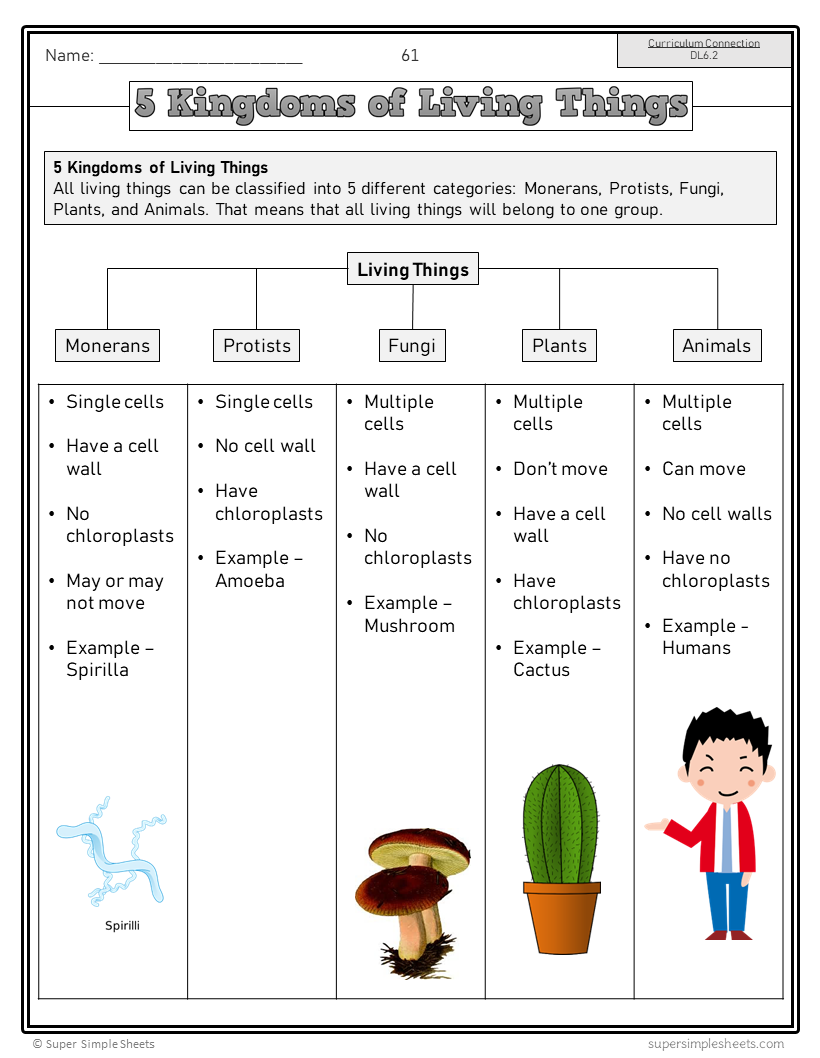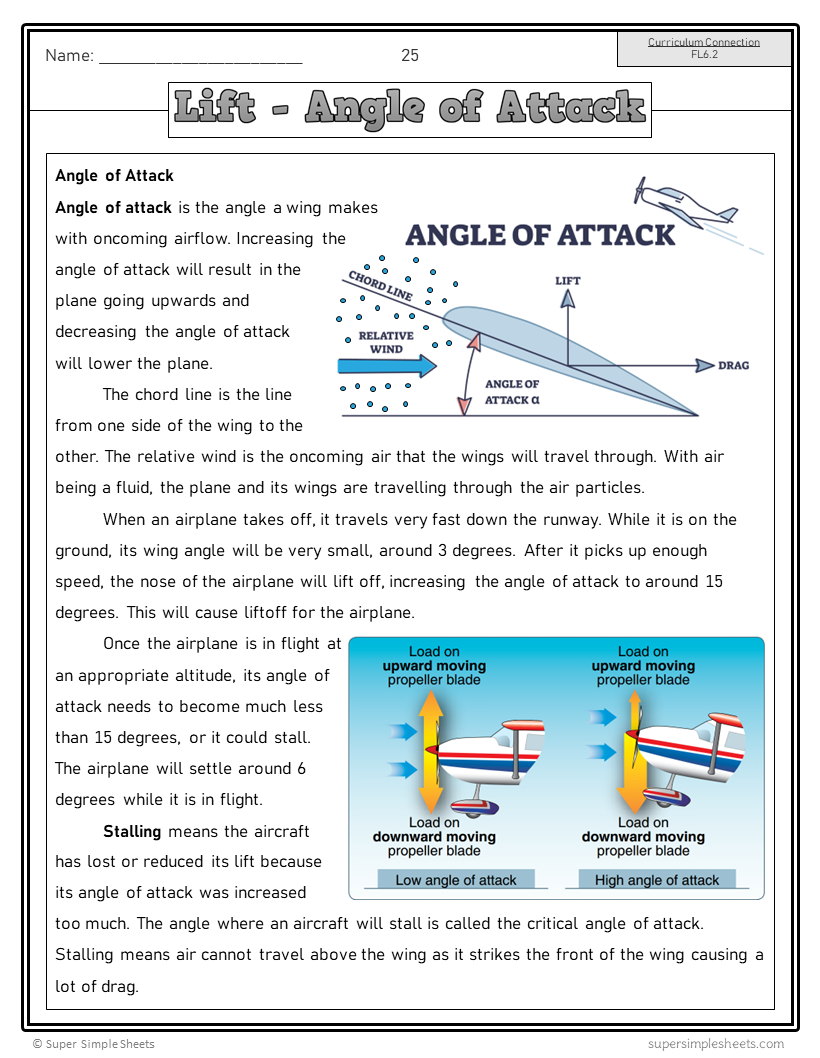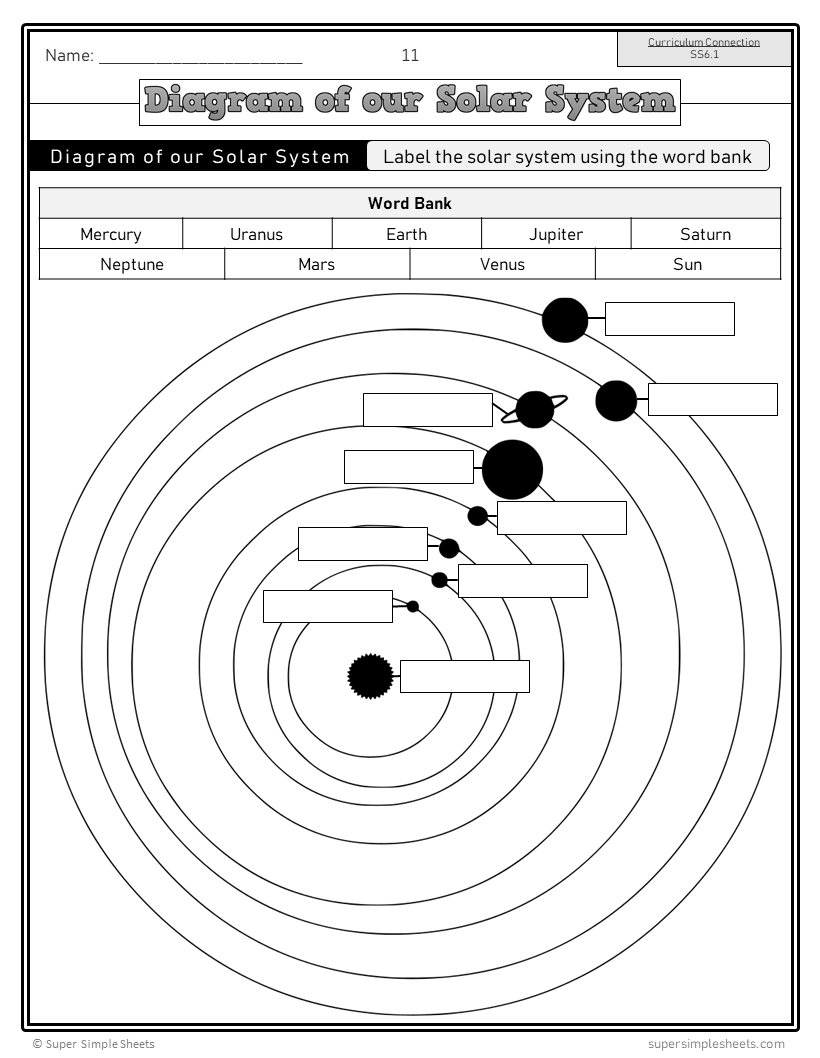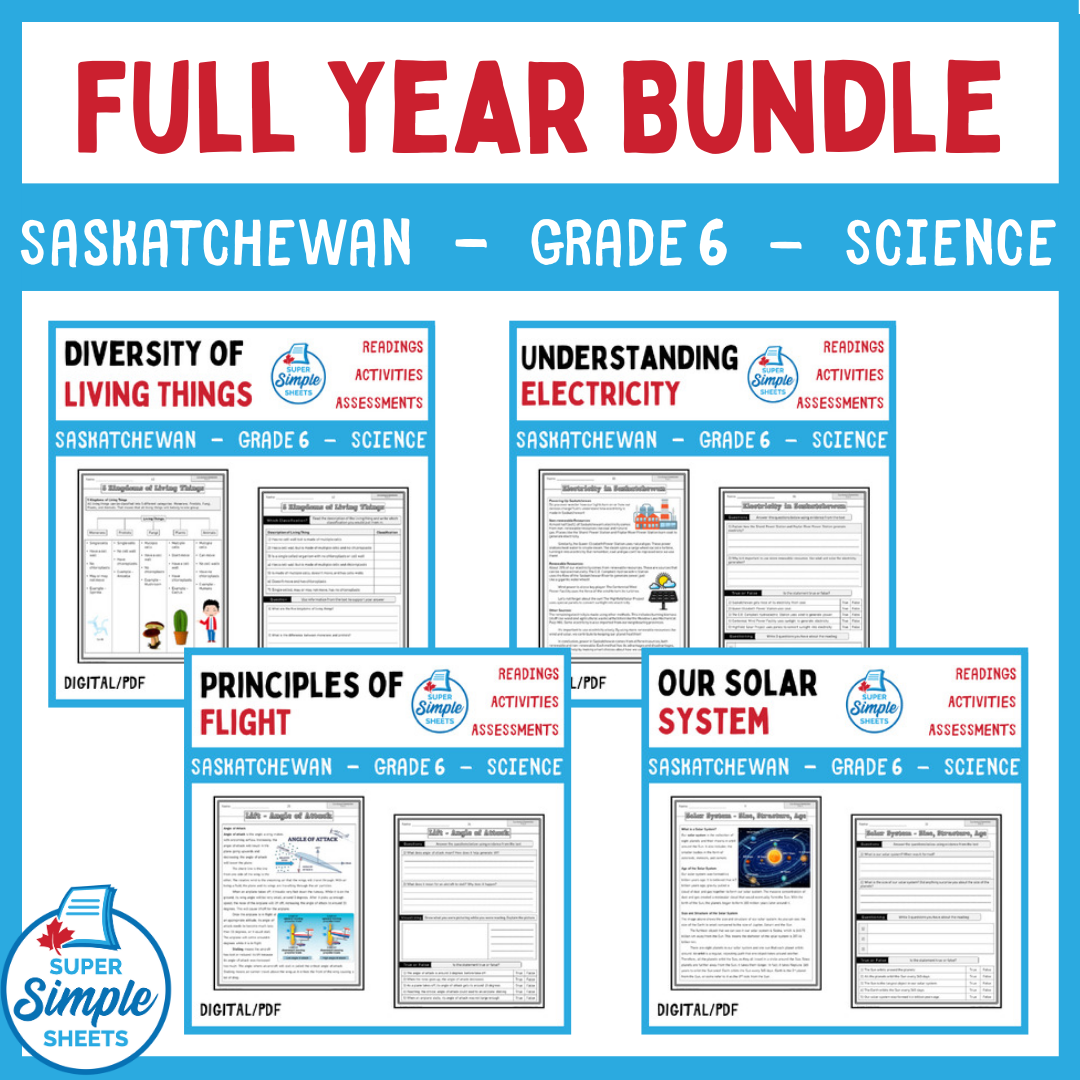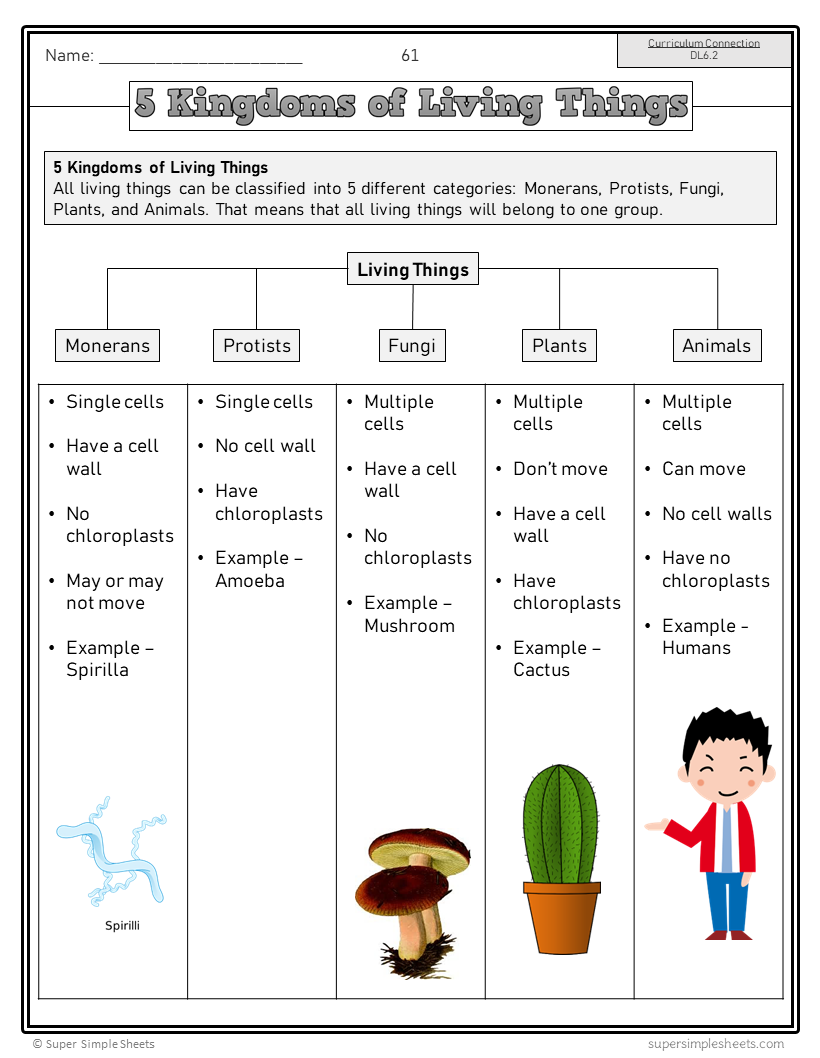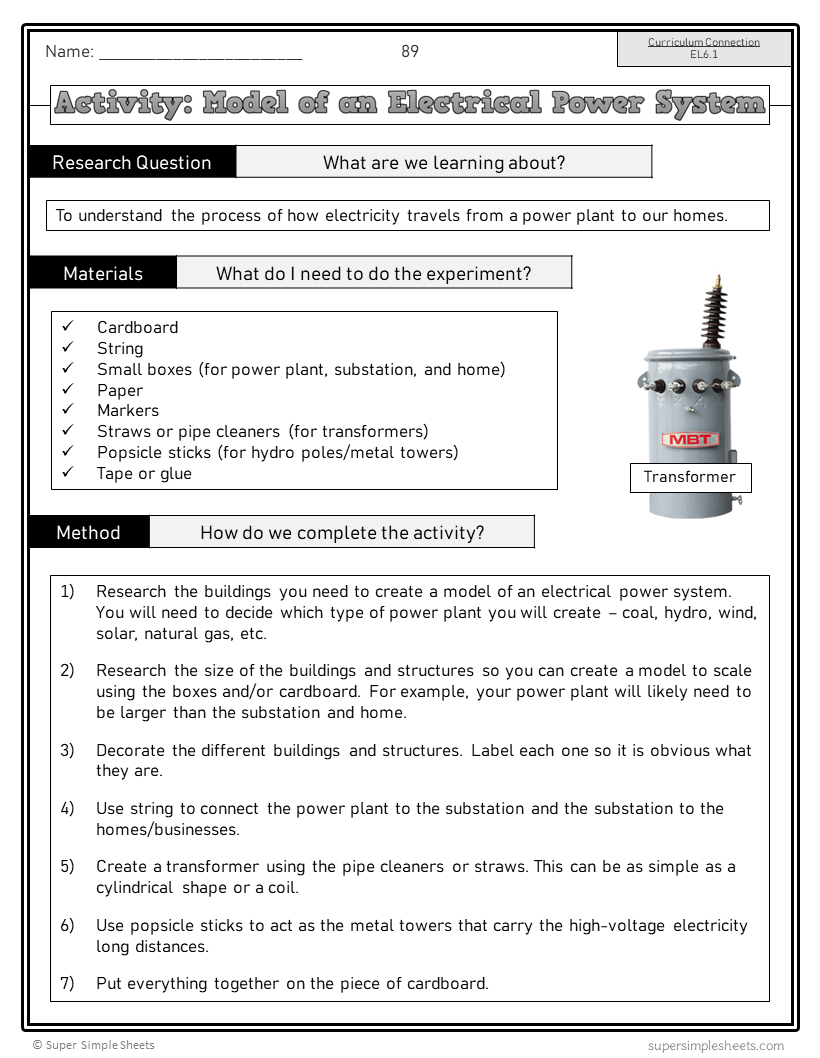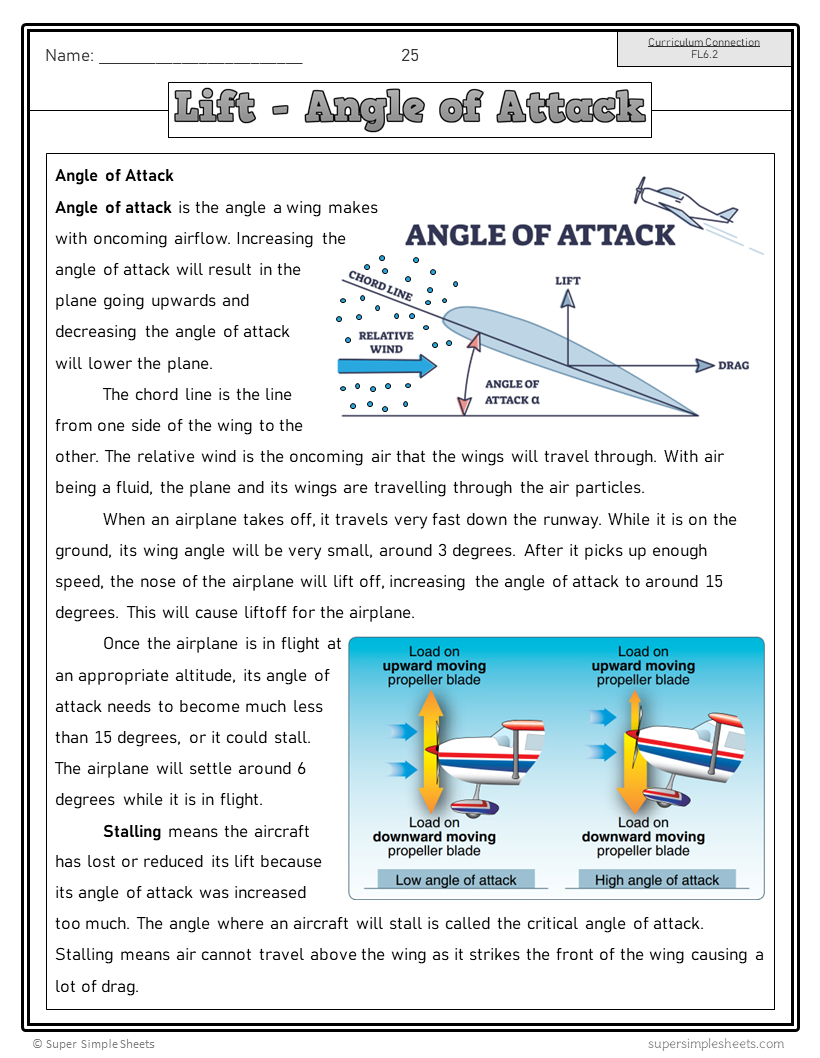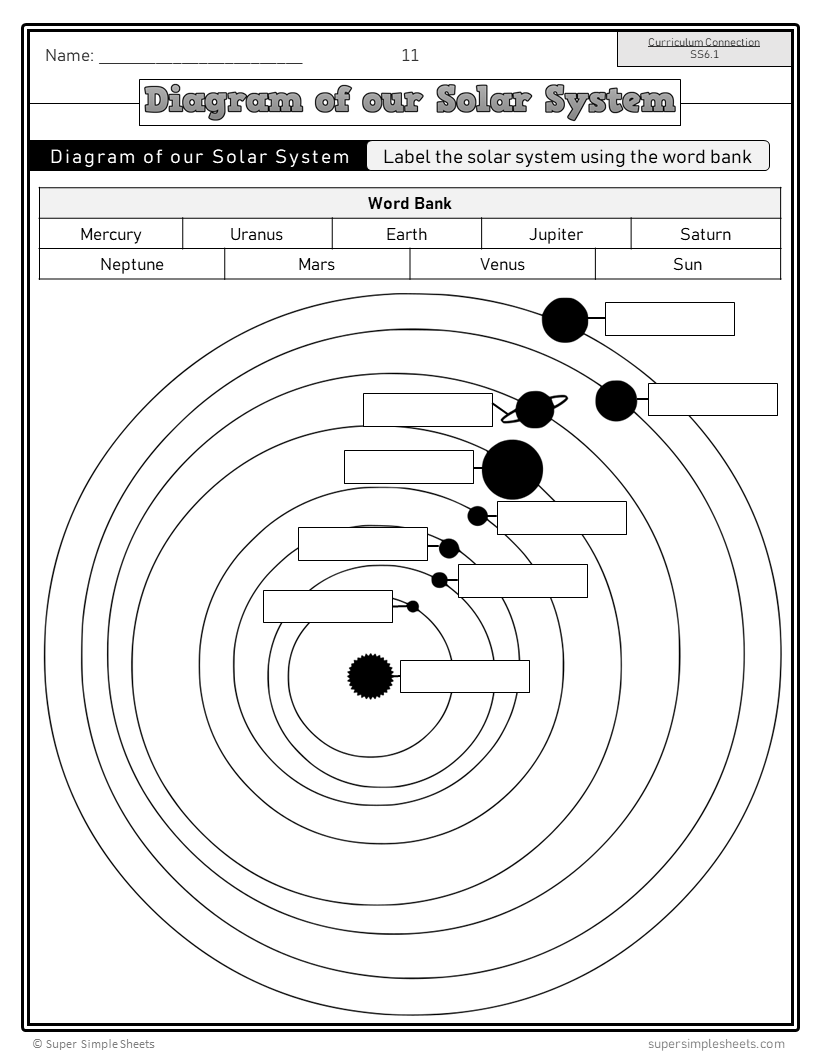Saskatchewan Grade 6 Science - Full Year Bundle - GOOGLE/PDF INCLUDED
Saskatchewan Grade 6 Science - Full Year Bundle - GOOGLE/PDF INCLUDED
Interested in a bundle? Shop below instead!
Couldn't load pickup availability
PRODUCT PREVIEW
Grade 6 – Saskatchewan Science Curriculum – This resource covers all outcomes and indicators in the Grade 6 - Saskatchewan Science Curriculum.
GOOGLE CLASSROOM VERSION - PDF INCLUDED! This gives you the ability to print worksheets as well as distribute a digital copy of the resource to your students on Google Classroom.
Check out each of the strands below to learn more about the resources included in this bundle.
Diversity of Living Things
Some of the concepts that are covered:
- Characteristics of living things
- Living things in your area
- Organisms, species, communities, and populations
- What does diversity of living things mean – biodiversity
- Activity – Building and monitoring bird feeders
- Effects on biodiversity when altering a food chain
- Longitudinal biodiversity gradient – more biodiversity near the equator
- Biodiversity in deserts, forests, grasslands, and oceans
- Research activities – learning more about biodiversity in different ecosystems
- Oceans – the deep ocean and ocean zones
- How the Indigenous rely on biodiversity
- Biodiversity and agriculture
- Biodiversity in your community
- Assignment – creating a biodiversity infographic
- What are classification systems?
- Classifying living things using different categories (number of legs, diet, body)
- 5 kingdoms of living things
- Classifying living things – microscopic organisms and visible organisms
- Classifying vertebrates and invertebrates
- Characteristics of birds, fish, mammals, reptiles, and amphibians (diet, body shape, reproduction, breathing)
- Characteristics of invertebrates – arthropods, annelids, and molluscs
- Experiment – building a vertebrate and invertebrate animal
- Experiment – designing a zoo enclosure that meets the needs of an animal
- Diets – herbivores, carnivores, and omnivores
- Classifying plants – flowering and non-flowering
- Classifying plants – vascular and non-vascular
- Biodiversity within species – white bunny versus brown (adaptations)
- Adapting species
- Darwin’s Finches – different beaks
- Genetic variation – peppered moths
- Diversity between species – different types of bears
- Relationships within species – wolf pack
- Symbiotic relationships between species
- All about microorganisms – basic needs
- Benefits of microorganisms – composting, vaccines, digestion
- Harmful microorganisms – food spoiling, diseases
- Research assignment – food preservation techniques
- Microscope diagram
- Experiment – using a microscope to see microorganisms in different types of water
- Unit test
- Answer pages for all activities
Understanding Electricity
Some of the concepts that are covered:
- What is electricity?
- Electrical devices we use
- Electrostatic force
- Static electricity and current electricity
- Dangers of static electricity and current electricity
- Experiment – creating static electricity
- How electricity works
- Dangers of short circuits
- Generating electricity – turbines and generators
- Conducting materials and insulating materials
- Lab experiment – conductors vs insulators
- Simple electrical circuits
- Reading circuit diagrams
- Drawing circuit diagrams
- Components of simple electrical circuits
- Activities – creating series circuits and parallel circuits
- Experiment – testing battery power
- Series vs parallel circuits
- Experiment – creating a model that produces electricity (potato battery)
- Electromagnetic forces
- Lab experiment – creating an electromagnet
- Transforming electricity into other forms of energy (heat, sound, and mechanical energy)
- Transforming electricity – the electric bell
- Electromagnetism and turbines (mechanical energy)
- Renewable vs non-renewable forms of energy
- Impacts of using electricity – downsides of different sources of electricity (solar, nuclear, wind, hydro, geothermal)
- How solar, nuclear, wind, and hydro energy transform into electricity
- Electricity generation in Saskatchewan – Power Plants in Saskatchewan
- Power Plants in Saskatchewan: E.B. Campbell Hydroelectric Station, Shand Power Station, Poplar River Power Station, The Centennial Wind Power Facility, and the Queen Elizabeth Power Station
- How electricity moves from power plants to our homes in Saskatchewan
- Research assignment – the James Bay Hydroelectric Project
- Measuring electricity in our homes
- Reading energy efficient labels – household appliances
- Evaluating your use of electricity – making a plan to reduce usage
- Binary code – computer language for electronics
- Remote controls using binary code
- Unit test
- Answer pages for all activities
Principles of Flight
Some of the concepts that are covered:
- History of aviation
- Trial and error – Wright Brothers first flight
- Properties of air related to flight
- Air is a fluid
- Science experiment - power of air pressure
- Science experiment – air compression
- Four forces of flight – drag, thrust, lift, weight (gravity)
- Lift – Bernoulli’s Principle and Newton’s Third Law of Motion
- Angle of Attack – generating lift
- Drag – aerodynamics
- Science experiment – creating a paper airplane (testing drag)
- Weight/Gravity – effect on flight (luggage)
- Mass vs weight – reading, activity, and experiment
- Thrust (propulsion) – reading, activity
- Science experiment – building a propeller
- Control surfaces of a plane – parts of a plane and how they balance the plane
- How animals fly
- Animal adaptations – dolphins and swallows
- Design features of flying devices and flying organisms – adapting drag
- Race cars using spoilers to prevent lift
- Aircrafts versus spacecrafts
- Parachutes – how they use air resistance (drag) to slow down aircrafts/people
- Science experiment – building and testing a parachute
- Lighter-than-air flying devices
- Science experiment - making a glider
- Benefits and drawbacks of aviation
- Assignment – creating an infographic about aviation
- First Nations and Métis Art and Storytelling – Birds (Thunderbird and the Raven)
- First Nations and Métis using technologies involving flight (Atlatl and Bow and Arrow)
- The Contributions of Canadians to Aviation – Bush Plains and the Silver Dart
- Autopilot – using code to fly planes
- Unit test
- Answer pages for all activities
Our Solar System
Some of the concepts that are covered:
- The Universe, Solar System, Galaxies, Planets
- Diagram of our Solar System
- Size of the Universe, Solar System, Milky Way Galaxy
- Classifying planets – gas giants and terrestrial planets
- Characteristics of gas giants
- Characteristics of terrestrial planets
- Assignment – planet profile
- What is the habitable zone?
- Potential life in our universe – Life on Mars, Kepler 186f, Europa: a moon of Jupiter
- Natural Satellites – moons
- Asteroids and the Asteroid Belt
- Meteors, meteorites, and meteoroids
- Identifying celestial bodies
- Gravity – reading and science experiment
- Mass versus weight – activity, reading, and experiment
- Constellations – stars in our galaxy
- The Aurora Borealis – First Peoples’ Perspective
- Haida perspective – Creation story involving the aurora borealis
- Indigenous constellation story – Great Bear Hunt (Mista Muskwa)
- Experiment – creating constellations on geoboards
- Conception of the Earth – Flat Earth, Geo-Centred Theory, and Sun-Centred Theory
- Day and night – Earth’s axis and rotation
- Day and night around the world – research assignment
- Experiment – making a sundial
- Seasons – Earth’s orbit around the Sun
- First Nation Storytelling: Fisher Brings the Summer – Anishinaabe Story
- The Woodland Cree's Six-Season Model
- Moons in our solar system – research assignment
- Phases of the moons – reading and experiment
- Ocean tides – lunar and solar tides
- Celestial objects visible in the night sky
- Canada and space exploration – technologies created by Canadians
- Space – extreme environment – temperature, zero gravity, air pressure
- Surviving in space – technologies needed
- Benefits of space exploration – using satellites
- Understanding climate change using space technologies – satellite images
- Mars Rovers – reading and research activity
- Controversy of space travel – downsides (dangerous and costly)
- Unit test
- Answer pages for all activities
This is a comprehensive bundle that will save you hours of planning! It has been tested and found effective in helping students achieve the learning outcomes in the science curriculum.
Answer pages for all slides/sheets are included!
Share
